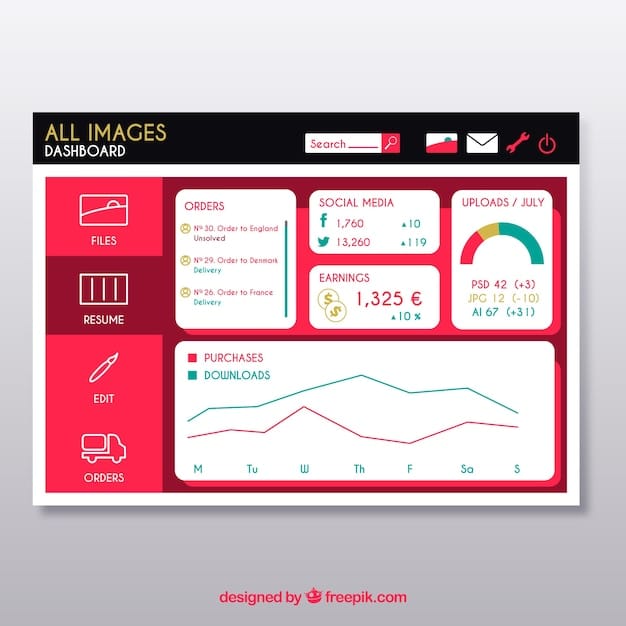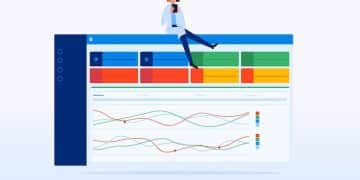E-commerce A/B Testing: Maximize Results & Optimize Campaigns

A/B testing in e-commerce is a systematic process of comparing two versions of a webpage, app, or marketing asset to determine which performs better in achieving a specific goal, crucial for optimizing user experience, conversion rates, and overall business growth.
In the dynamic world of online retail, simply having a product isn’t enough; understanding your customer’s journey and continuously refining your approach is paramount. This is where E-commerce A/B Testing: Optimize Your Website and Marketing Campaigns for Maximum Results becomes an indispensable strategy. It’s not merely about making changes, but about making data-driven decisions that propel your business forward.
Understanding the Core of A/B Testing in E-commerce
A/B testing, also known as split testing, is a controlled experiment where two or more versions of a variable (A and B) are shown to different segments of your audience at the same time to determine which version performs better against a defined goal. For e-commerce, this usually translates to higher conversion rates, increased average order value, or improved user engagement.
The beauty of A/B testing lies in its scientific approach. Instead of guessing what might work, you gather empirical evidence. This methodology eliminates subjectivity and allows you to make informed decisions that directly impact your bottom line. It’s about constant iteration and improvement, turning your e-commerce site into a finely tuned conversion machine.
The “Why” Behind A/B Testing
Many e-commerce businesses are leaving money on the table simply because they haven’t adopted a rigorous testing culture. A/B testing isn’t a luxury; it’s a necessity for sustained growth in a competitive online landscape. It helps uncover hidden opportunities and fix conversion roadblocks you might not even be aware of.
- 📈 Identify what truly resonates with your audience.
- 💰 Boost conversion rates without increasing traffic spend.
- 📉 Reduce bounce rates and improve user retention.
- 🎯 Personalize user experience based on data.
- 💡 Validate new ideas and features before full implementation.
Ultimately, A/B testing empowers you to move beyond assumptions and base your strategic decisions on concrete data, fostering a culture of continuous improvement that is vital for long-term success in the ever-evolving e-commerce environment.
Key Elements to A/B Test for E-commerce Success
The scope of A/B testing in e-commerce is vast. Practically any element on your website or within your marketing campaigns can be tested. However, focusing on high-impact areas first typically yields the most significant results. These often include elements directly influencing a customer’s decision to purchase.
Consider the entire customer journey, from the moment they land on your site to the final checkout. Each touchpoint offers a potential opportunity for optimization. Small changes can often lead to surprisingly large gains when multiplied across thousands of visitors.
Website Elements Worth Testing
Your e-commerce website is your storefront. Every button, image, and piece of text influences how a user interacts with your brand. Testing these elements ensures your storefront is as welcoming and efficient as possible.
- Product Pages: Optimize product descriptions, images (angles, zoom, lifestyle shots), video integration, call-to-action (CTA) button copy and color, pricing display, trust badges, and social proof (reviews, testimonials).
- Homepage Layout: Experiment with hero images, navigation menus, promotional banners, product categories display, and search bar placement.
- Checkout Process: Test the number of steps, form field design, guest checkout options, shipping options display, payment gateway icons, and progress indicators.
- Landing Pages: Refine headlines, body copy, lead magnet offers, form length, and visual hierarchy.
Beyond these, consider elements like site search functionality, internal linking strategies, and even the clarity of your return policy. Every detail contributes to the overall user experience and conversion funnel.

Marketing Campaign Elements
Your marketing campaigns are the first interaction many potential customers have with your brand. Optimizing them ensures you are attracting the right audience and converting them effectively.
It’s not just about getting clicks; it’s about getting the *right* clicks that lead to conversions. A/B testing allows you to refine your messaging and targeting, making your ad spend more efficient and effective.
- Email Marketing: Test subject lines, sender names, personalization tokens, email template layouts, CTA buttons, image placement, and timing of sends.
- Paid Ads (Google Ads, Social Media Ads): Experiment with headlines, ad copy, images/videos, CTA text, landing page alignment, audience targeting, and bidding strategies.
- Social Media Posts: Analyze different types of content (image vs. video, carousel vs. single post), caption length, hashtags, and posting times.
Remember that the goal of marketing campaign testing is often to drive specific actions, such as clicks to a product page or sign-ups for a newsletter, which then feed into your on-site conversion funnel.
Setting Up Your A/B Test: A Methodical Approach
Successful A/B testing isn’t random; it’s a structured process that requires careful planning and execution. A haphazard approach can lead to misleading data and wasted effort. Adopting a methodical framework ensures your tests are reliable and actionable.
The core principle is isolating a single change to accurately attribute any performance differences. Introducing multiple variables simultaneously makes it impossible to determine which specific change caused the observed outcome.
Defining Your Hypothesis and Goals
Before you run any test, you need to clearly define what you’re testing, why you’re testing it, and what success looks like. This initial step is critical for staying focused and ensuring your efforts are meaningful.
A well-formulated hypothesis typically follows an “If… then… because…” structure. For example, “If we change the CTA button color from blue to orange, then we will see an increase in clicks, because orange stands out more against the page background.”
- Identify the Problem: What specific issue are you trying to solve? (e.g., low add-to-cart rate, high bounce rate on homepage).
- Formulate a Hypothesis: What change do you think will solve it? Why?
- Define Your Metrics: How will you measure success? (e.g., conversion rate, click-through rate, average order value). Ensure these are quantifiable and directly related to your hypothesis.
Having clear goals and a strong hypothesis ensures that your A/B test is focused and provides meaningful insights, rather than just generating data for the sake of it.
Tools, Traffic, and Duration
Choosing the right tools and understanding the technical requirements are just as important as defining your hypothesis. The execution phase needs to be carefully managed to ensure valid results.

Insufficient traffic or ending a test too early are common pitfalls. These can lead to statistically insignificant results, meaning you can’t confidently say that one version truly outperformed the other due to random chance.
- A/B Testing Tools: Utilize platforms like Google Optimize (soon to be sunsetted, with alternatives like Optimizely, VWO, or Adobe Target) to implement and monitor your tests.
- Traffic Considerations: Ensure you have sufficient traffic to reach statistical significance. The more significant the difference you want to detect, and the smaller your baseline conversion rate, the more traffic you’ll need.
- Test Duration: Run tests for a minimum of one to two full business cycles (e.g., two weeks) to account for daily and weekly variations in user behavior. Avoid stopping tests early just because one variant appears to be winning. Patience is key.
Monitor your tests regularly, but avoid making impulsive decisions based on early data. Let the test run its course to gather enough data for a robust conclusion.
Analyzing Results and Iterating
Once your A/B test has concluded and reached statistical significance, the real work of analysis begins. This is where you translate raw data into actionable insights that inform your future optimization efforts. It’s not just about declaring a winner, but understanding *why* it won.
A false positive, where you implement a change based on data that isn’t truly significant, can erode trust in your A/B testing program and lead to suboptimal business decisions. Therefore, a careful and critical assessment of the data is paramount.
Interpreting Statistical Significance
Statistical significance tells you how likely it is that the observed difference between your A and B variants is due to the changes you made, rather than random chance. A common threshold is 95% or 99%.
If your test results are not statistically significant, it means you cannot confidently say that one version is better than the other. In such cases, the best approach might be to continue with the original variation, run a new test with bolder changes, or re-evaluate your hypothesis.
- P-Value: Understand that a lower p-value means a higher statistical significance. Aim for a p-value of less than 0.05 (for 95% significance).
- Confidence Interval: This range indicates where the true mean often lies. Overlapping confidence intervals between variants suggest no clear winner.
- Sample Size: Verify that you had enough visitors to draw meaningful conclusions. Tools often provide calculators for minimum required sample size.
Don’t just look at the overall conversion rate. Drill down into segments (e.g., new vs. returning visitors, mobile vs. desktop, specific traffic sources) to uncover more nuanced insights and identify specific user behaviors.
Learning from Losers and Iterating
Even if a variant “loses,” the test isn’t a failure. It’s an opportunity to learn. Understanding why something didn’t work can be just as valuable as knowing why something did. This iterative process is the hallmark of effective optimization.
Every test, regardless of the outcome, provides valuable data points that contribute to your cumulative understanding of your audience and their online behavior. This knowledge builds over time, leading to more sophisticated and impactful future tests.
- Document Everything: Keep a detailed log of all tests, hypotheses, results, and learnings. This prevents repeating past mistakes and builds a knowledge base.
- Formulate New Hypotheses: Based on your findings, develop new hypotheses for the next round of tests. A losing variant might simply need a different tweak.
- Continuous Optimization: A/B testing is not a one-time project but an ongoing process. The market, your products, and customer behavior constantly evolve, so your optimization efforts must too.
Embrace the “fail fast, learn faster” mindset. Each test brings you closer to understanding what truly drives conversions for your e-commerce business.
Advanced A/B Testing Strategies for E-commerce
Once you’ve mastered the basics, you can explore more sophisticated testing methodologies that allow for a deeper understanding of user behavior and more complex optimizations. These strategies move beyond simple A/B comparisons to explore multiple variables or entire user journeys.
While more complex, these approaches can unlock significant gains by uncovering interactions between different elements that might not be apparent in simpler tests. They require more technical expertise and traffic, but their potential payoff is higher.
Multivariate Testing vs. A/B Testing
While A/B testing changes one variable at a time, multivariate testing (MVT) allows you to test multiple variables simultaneously to understand how different combinations perform. This is particularly useful for redesigns or complex page alterations where many elements are changing.
However, MVT requires significantly more traffic and a longer testing period to reach statistical significance due to the exponential increase in combinations. It’s best suited for high-traffic sites with complex optimization needs.
- When to Use A/B: Ideal for single, impactful changes like CTA color, headline, or image. Faster to implement and analyze.
- When to Use MVT: Best for optimizing entire sections with multiple interactive elements, such as a product page with variations in image gallery, description layout, and review section.
Choose the right testing method based on the scope of your changes and the volume of your traffic to ensure efficient and reliable results.
Personalization and Segmentation
Beyond traditional A/B testing, leveraging personalization and segmentation can elevate your optimization efforts. This involves showing different versions of your site or campaigns to specific user groups based on their demographics, behavior, or previous interactions.
For example, a returning customer who previously viewed a particular product category might see a different homepage banner or product recommendations than a new visitor. This level of tailored experience can significantly boost engagement and conversions.
- Behavioral Targeting: Segment users by their past actions (e.g., abandoned carts, repeat purchases, browsing specific categories).
- Demographic Segmentation: Tailor content based on age, location, gender, etc.
- Source-based Personalization: Show different content to users arriving from paid ads versus organic search or email campaigns.
Personalization, driven by robust A/B testing and segmentation, moves beyond a one-size-fits-all approach to create highly relevant experiences that resonate deeply with individual customers, driving loyalty and increased lifetime value.
Common Pitfalls and Best Practices in E-commerce A/B Testing
While A/B testing offers immense opportunities, it’s not without its challenges. Understanding common mistakes and adhering to best practices can save you time, resources, and prevent drawing erroneous conclusions from your tests. Many businesses dive in without a clear understanding of the nuances involved.
Avoiding these pitfalls is crucial for the integrity of your data and the effectiveness of your optimization strategy. A poorly executed test can be worse than no test at all, as it can lead to misinformed decisions.
Avoiding Common A/B Testing Mistakes
Even seasoned optimizers can fall victim to these common errors. Being aware of them is the first step towards conducting more robust and reliable tests.
- Not Enough Traffic/Duration: Stopping a test too early or running it with insufficient traffic leads to statistically insignificant results (Type I or Type II errors).
- Testing Too Many Elements at Once: Avoid “shotgun testing” where multiple changes are introduced simultaneously, making it impossible to attribute success or failure to a specific variable.
- Ignoring External Factors: Seasonality, marketing campaigns launching simultaneously, holidays, or competitors’ promotions can skew results. Schedule tests carefully.
- Improper Implementation: Technical issues like flickering (FOOC), incorrect tracking, or caching problems can invalidate your tests. Always double-check setup.
- Lack of Clear Hypothesis: Testing without a clear “why” and “what to improve” leads to aimless experimentation.
Patience, attention to detail, and a rigorous adherence to scientific methodology are your best allies in navigating the complexities of A/B testing.
Best Practices for Continuous Optimization
Building a successful A/B testing program is an ongoing journey that requires commitment and a systematic approach. These practices ensure your efforts yield maximum results over time.
It’s not just about running tests; it’s about embedding a culture of experimentation and data-driven decision-making throughout your organization. This long-term view transforms your e-commerce operations.
- Start Small, Think Big: Begin with small, impactful tests, then scale up to more complex experiments as you gain experience and insights.
- Prioritize Impact: Focus on testing elements that have the potential for the largest positive impact on your key metrics.
- Document and Share Learnings: Create a central repository for all test results and share insights across teams to build collective intelligence.
- Focus on User Experience: While boosting conversions is key, ensure your tests also contribute to a better, more intuitive user experience. Long-term customer satisfaction is paramount.
- Integrate with Analytics: Connect your A/B testing tool with your analytics platform (e.g., Google Analytics) for deeper insights and cross-validation of data.
By consistently applying these best practices, you can establish a robust testing framework that continually optimizes your e-commerce website and marketing campaigns, leading to sustained growth and competitive advantage.
| Key Point | Brief Description |
|---|---|
| 📊 Data-Driven Decisions | A/B testing replaces assumptions with empirical evidence to optimize performance. |
| 🎯 High-Impact Elements | Focus on testing product pages, checkout, and marketing campaigns for best returns. |
| 📈 Statistical Significance | Ensure tests run long enough with sufficient traffic for reliable, actionable results. |
| 🚫 Avoid Pitfalls | Steer clear of common mistakes like testing too many variables or premature conclusions. |
Frequently Asked Questions About E-commerce A/B Testing
A “good” conversion rate varies significantly by industry, product, traffic source, and average order value. Generally, e-commerce conversion rates hover between 1% and 4%. However, top performers can achieve rates higher than 5%. Continuous A/B testing is essential for improving your specific baseline.
An A/B test should run long enough to achieve statistical significance and also to account for weekly cycles in user behavior. Typically, this means a minimum of one to two full business cycles, often a period of one to four weeks. Avoid stopping tests early based on initial results.
When done correctly, A/B testing does not typically harm SEO. Google provides guidelines for testing. Ensure your canonical tags are properly set, avoid cloaking, and prevent showing different content to search engine bots than to users. Ultimately, successful A/B tests improve user experience, which is beneficial for SEO.
Statistical significance indicates the probability that the observed difference between your test variations is not due to random chance. A 95% significance level means there’s a 5% chance the results are coincidental. It’s crucial for confidently declaring a winner and making data-driven decisions based on solid evidence.
Prioritize testing elements that have the most direct impact on conversion or revenue, and those with enough traffic to yield swift results. Common starting points include call-to-action buttons (copy, color, placement), product page layouts, or the checkout process steps. Address known pain points first.
Conclusion
E-commerce A/B Testing: Optimize Your Website and Marketing Campaigns for Maximum Results is not a fleeting trend but a fundamental practice for any online business aiming for sustainable growth. By embracing a systematic approach to experimentation, continuous learning, and data-driven decision-making, you move beyond guesswork and sculpt an online experience that truly resonates with your customers. The journey of optimization is ongoing, always adapting to changing consumer behaviors and competitive landscapes, ensuring your e-commerce venture not only survives but thrives.





